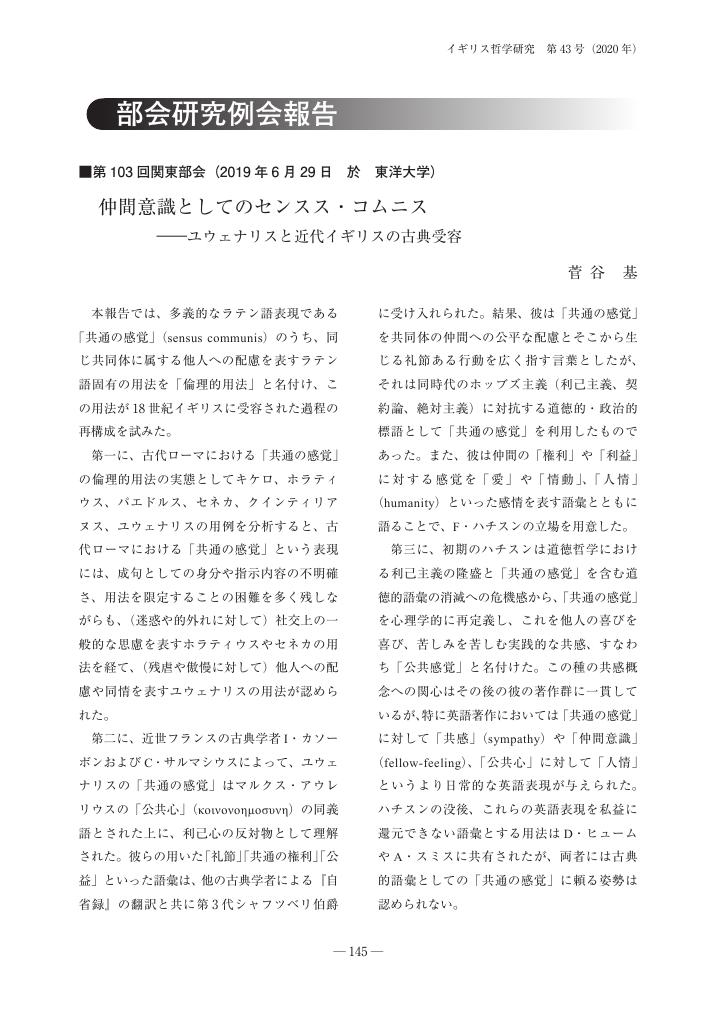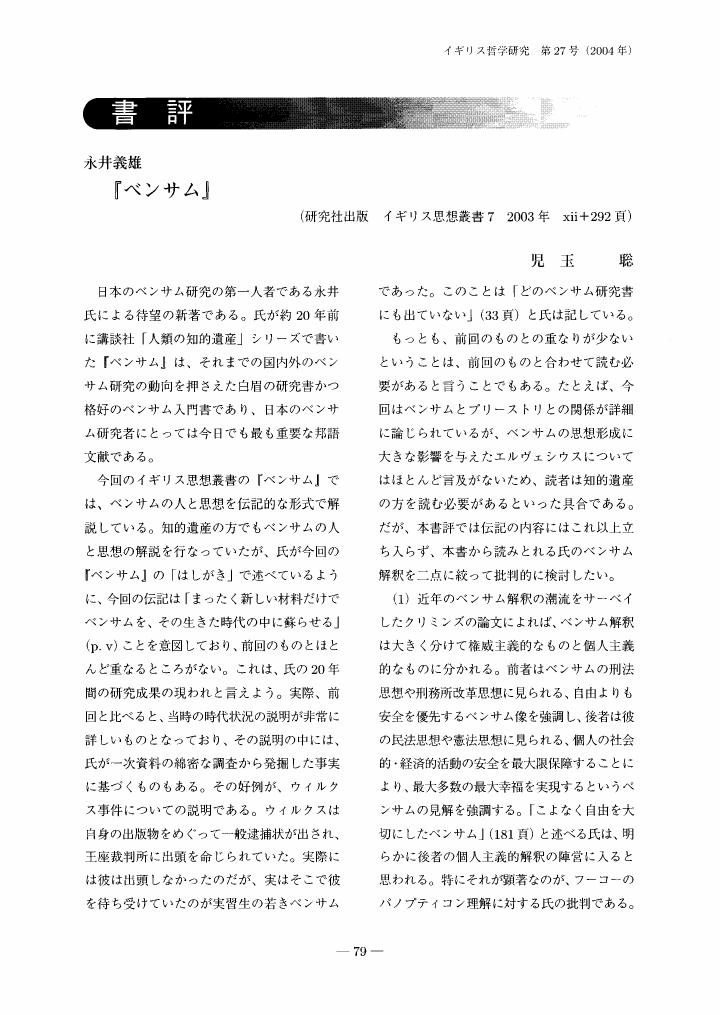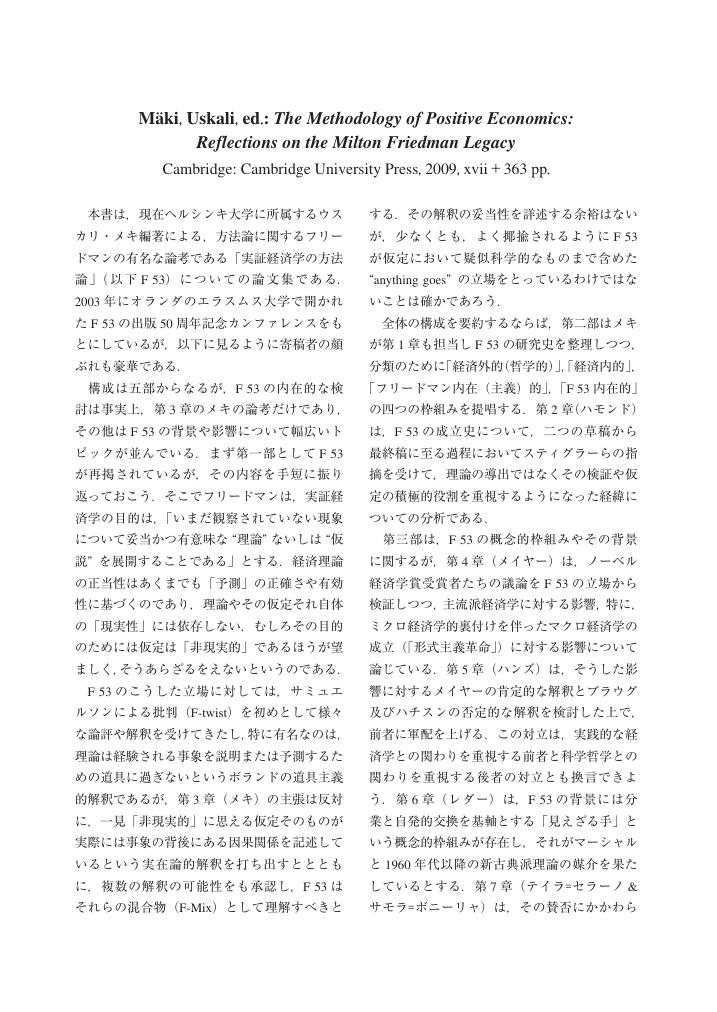- 著者
- 太子堂 正称
- 出版者
- 日本イギリス哲学会
- 雑誌
- イギリス哲学研究 = Studies in British Philosophy : the journal of the Japanese Society for British Philosophy (ISSN:03877450)
- 巻号頁・発行日
- no.43, pp.126-128, 2020
4 0 0 0 OA ハイエクにおける自然と自然法の概念
- 著者
- 太子堂 正称
- 出版者
- 京都大學經濟學會
- 雑誌
- 經濟論叢 (ISSN:00130273)
- 巻号頁・発行日
- vol.175, no.5-6, pp.486-503, 2005-06
3 0 0 0 OA ハイエクとヒューム, スミス
- 著者
- 太子堂 正称
- 出版者
- The Japanese Society for the History of Economic Thought
- 雑誌
- 経済学史学会年報 (ISSN:04534786)
- 巻号頁・発行日
- vol.43, no.43, pp.52-67, 2003 (Released:2010-08-05)
- 参考文献数
- 27
The purpose of this paper is to compare the arguments of D. Hume and A. Smith with those of F. A. Hayek, a representative of modern liberalism, based on analysis of the justice theory, and to explain common ideas and differences between them.While the thought of Hayek is based on a Kantian position, that of Hume and Smith is based on Scottish tradition. They share, however, a common viewpoint of “Empirical natural jurisprudence.” As such, although they differ in their ideological bases, there are ways in which Hayek paid close attention to Hume and Smith.Hayek names his liberalism “anti-rationalism” and believes Hume and Smith to be his pioneers. The arguments of these three philosophers have in common the concept of a negative justice theory based on the natural law tradition. Hayek inherited the idea of “the sense of justice” from Hume's notion of “a general sense of common interest” grounded on “conventions.” In addition, he succeeded in criticizing the “man of system” who will design or construct social order by a human's pure reason, and Smith's concept of a “great society.”While these three philosophers dismiss the notion of a human's pure reason (ex., Descartes), the foundation of reason from a theological perspective (ex., Hutcheson), and law positivism (ex., Kelsen), they ask for an historical and secular formation of the foundation of a natural law (or natural jurisprudence). The above constitutes their “Empirical natural jurisprudence”. The traditions of natural law before Hume were based entirely on teleology or Platonism. But Hume and Smith eliminated both teleology and Platonism from their notion of natural jurisprudence. Hayek inherited this perspective from both and combined it with his Kantian position. More specifically, Hayek's social theory belongs to a genealogy of natural jurisprudence that has historical and Kantian-transcendental character. “The sense of justice” that is historically formulated operates as a “Kantian-regulative idea.”The justice theories of Hayek, Hume, and Smith are all based on the “limited generosity” of humans, a “scarcity of a sufficient means of desire, ” and “self-interest.” For the three philosophers, general “law” appears to be a “reasonable expectation” formed over the long run throughout history.There are, however, differences among these three with regard to what they believed to be the appropriate role of government and to “cultural evolution.” Although Hayek believes in the idea of spontaneous order, in which evolution occurs as an unintended result of human action, Hume and Smith were deeply aware of the need for artificial roles in the evolution of various institutions.In Hayek's theory, there is no concept of “sympathy” or “virtue, ” as seen in Hume and Smith. This point greatly separates both Hume and Smith from Hayek. If we compare Hume and Smith, Smith respected virtue more than Hume, and Hume considered custom to be more important than did Smith. Such differences in their theory result from methodological differences, and they are important to their differences in their social theory, especially concerning the problems of government and the public sphere. Smith's concept of “sympathy” was more sophisticated than that of Hume, and he established the unique concept of an impartial spectator. In contrast, Hayek developed the idea of abstract knowledge (based on Kantian-apriorism).
2 0 0 0 OA 書評
1 0 0 0 OA 利己心の系譜学
- 著者
- 太子堂 正称 井上 義朗 間宮 陽介 桑田 学 原谷 直樹 野原 慎司 高橋 泰城 板井 広明 江頭 進 小沢 佳史 佐藤 方宣 笠井 高人 高橋 聡 村井 明彦
- 出版者
- 東洋大学
- 雑誌
- 基盤研究(B)
- 巻号頁・発行日
- 2015-04-01
本研究は、現代の経済理論が前提としている人間像について、その思想的系譜を解明することを目指して行われた。スコットランド啓蒙における「経済学の成立」から現代の行動経済学・神経経済学へと至るまでの野党な経済学者、理論の分析を通じて、効用や利潤の最大化を図る利己的人間観が登場してきた過程だけではなく、それぞれの経済思想家の主張の背後には、利他性や社会性を含む多様な人間像が含まれていたことが明らかとなった。
1 0 0 0 OA 大会報告
1 0 0 0 OA 部会研究例会報告
1 0 0 0 OA 書評
1 0 0 0 OA 書評
1 0 0 0 OA 書評
1 0 0 0 OA ハイエクにおける「科学主義」批判と「新自由主義」批判
- 著者
- 太子堂 正称
- 出版者
- 愛知学院大学経済学会
- 雑誌
- 愛知学院大学論叢. 経済学研究 = THE KEIZAIGAKU KENKYU : THE AICHI GAKUIN ECONOMIC REVIEW (ISSN:21882010)
- 巻号頁・発行日
- vol.9, no.2, pp.53-70, 2022-03-30
- 著者
- 太子堂 正称
- 出版者
- 経済学史学会
- 雑誌
- 経済学史研究 (ISSN:18803164)
- 巻号頁・発行日
- vol.58, no.2, pp.69-71, 2017 (Released:2019-11-30)
1 0 0 0 OA 楠茂樹・楠美佐子『ハイエク――「保守」との訣別』中央公論新社,2013年,226頁
- 著者
- 太子堂 正称
- 出版者
- 経済学史学会
- 雑誌
- 経済学史研究 (ISSN:18803164)
- 巻号頁・発行日
- vol.56, no.2, pp.143, 2015 (Released:2019-11-30)
- 著者
- 太子堂 正称
- 出版者
- 経済学史学会
- 雑誌
- 経済学史研究 (ISSN:18803164)
- 巻号頁・発行日
- vol.53, no.2, pp.118-119, 2012 (Released:2019-10-30)
- 著者
- 太子堂 正称
- 出版者
- 経済学史学会
- 雑誌
- 経済学史研究 (ISSN:18803164)
- 巻号頁・発行日
- vol.52, no.1, pp.116-117, 2010 (Released:2019-10-25)
1 0 0 0 IR トマス・リードとコモンセンス学派研究の現段階
- 著者
- 田中 秀夫 太子堂 正称
- 出版者
- 京都大學經濟學會
- 雑誌
- 経済論叢 (ISSN:00130273)
- 巻号頁・発行日
- vol.167, no.5, pp.555-577, 2001-05
1 0 0 0 OA ハイエク「道徳哲学」研究序説
1 0 0 0 ハイエクにおける共和主義
- 著者
- 太子堂 正称
- 出版者
- 創文社
- 雑誌
- 創文 (ISSN:13436147)
- 巻号頁・発行日
- no.526, pp.16-19, 2009-12









